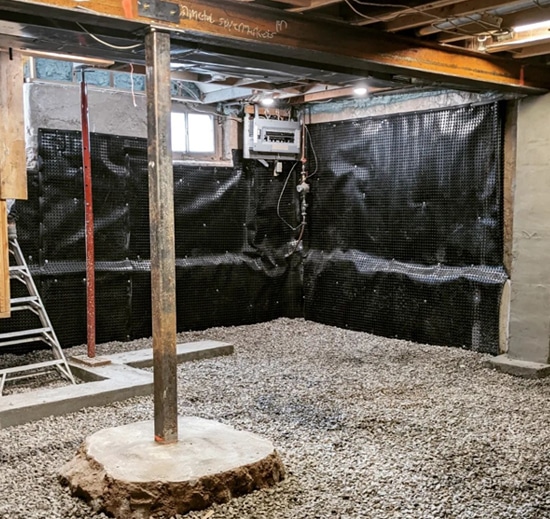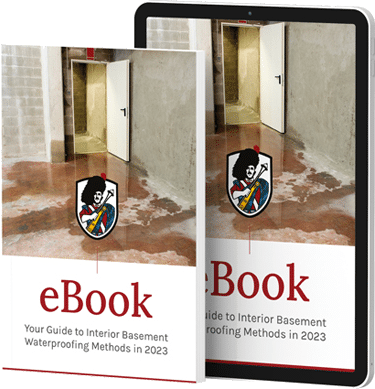Basement Waterproofing Toronto & GTA
Our Services Are Trusted By








Trouble With a Leaky and Wet Basement?
In the past, basements were typically not considered a significant selling point; they were often seen as little more than crawl spaces or laundry areas, and thus could be overlooked or neglected. However, over time, if water accumulates in your basement, it can lead to the development of multiple cracks and holes in the walls, resulting in water leakage during rainy seasons. Basement walls are subjected to significant stress due to changing weather conditions and continuous hydrostatic pressure, which can slowly cause cracks to form. Without adequate foundation waterproofing, basement walls are at risk of leaking during a rainy season.
Damp basements are also an invitation for mould and mildew to flourish. Mould and mildew are serious health hazards that can create a musty smell in your basement. People lose valuable items during basement flooding, rendering the basement practically unusable. If your basement does not have a proper waterproofing system, we highly recommend getting a professional quote for Toronto basement waterproofing from experts like GJ MacRae.

Expert Basement Waterproofing Services Toronto
GJ MacRae Foundation Repair is one of Toronto’s most renowned names for basement waterproofing. We have served the Greater Toronto Area, Hamilton, Etobicoke, Mississauga, Toronto, Oakville, Burlington, Milton, Georgetown, and surrounding areas since 1975. With almost five decades of experience, we have served over 10,000+ customers. These numbers speak for themselves and have been backed by our quality service. We are a completely family-owned, Toronto-based basement waterproofing company, currently in its second generation, and we take great pride in our work. The quality of our service is second to none, and we can guarantee that.
We also offer a transferable 15-year warranty for all our services, and our highly experienced staff and cutting-edge repair methods are second to none. For the finest basement waterproofing service in Toronto and the GTA (yes, even during the winter), call us today at (905) 824-2557
Benefits of a Dry Basement
What does a dry basement mean to you? A healthy, dry, livable, mould/mildew free, musty smell free, usable space? On top of that, a dry basement also promotes a healthy long-term structure and foundation. Let’s discuss the benefits of a dry basement:

Get More Livable Space
What's good about a wet basement? Nothing! A dry basement opens up many possibilities and translates to more livable space in your home. You can use the basement as a movie room, a game room, a gym, a bedroom, or an apartment.

Peace of Mind
We have a lot on our minds, and a leaky basement should not be one of those things. You should be able to check off a leaky basement from your list of troubles during the rainy season. Get interior basement waterproofing services from GJ MacRae, and be assured that your basement is dry and won’t damage all your valuables during the rainy season.

Stronger Foundation Support
Waterproofing your basement walls ensures your walls are dry and do not have to endure water damage. Also, the hydrostatic pressure is highly reduced with a waterproofing system installed around your basement walls. Any holes or cracks in your basement walls are fixed during basement waterproofing. This promotes a damage-free and strong foundation wall. A stronger foundation means more robust support for your house.

Higher Selling Price
In addition to the previously mentioned benefits, there's one more advantage you can enjoy while residing in your home: the added value when selling it. A dry, usable basement is highly sought after in today's market, and every prospective buyer will value a sturdy basement foundation that offers extra livable space. By investing in basement waterproofing now, you can reap these benefits while you live in the home and also when it comes time to sell.

Get Rid of That Musty Smell
A wet basement only invites trouble. Mould and mildew is a byproduct of basement leaks, but a dry basement means that your walls are mould and mildew free. A consistently damp and musty wet basement not only produces unpleasant odors but also poses significant health risks. Exterior basement waterproofing prevents water from entering through your foundation walls, while interior waterproofing addresses any additional leakage issues if there are external access concerns.
8-Step Basement Waterproofing Process:
01
The very first step is to locate the cracks in the foundation walls. We then set up tarps and begin hand excavation down to the footings. Going to the bottom of the footings is essential to completely repair the cracking.
02
We then clean the exposed walls with a wire brush and chisel out the cracks, allowing the quick setting of the hydraulic cement applied to the cracks with a trowel.
03
After the hydraulic cement is set, we apply a layer of quick-drying primer to the exposed walls. The purpose of this primer is to enhance the adhesion for our next step in basement waterproofing.
04
A special rubberized membrane is applied to the entire wall using a trowel. This rubberized membrane is impenetrable to water, air, or moisture. A layer of fiberglass mesh is also applied to provide flexibility to the membrane while keeping its integrity. Another layer of rubberized membrane is applied over the top, creating a double coat and extra protection.
05
While the patch is still tacky, we install a layer of thick plastic on the surface of the rubberized membrane. We have installed drainage boards on top of all our waterproofing layers. This acts as an additional layer that prevents water from getting into the foundation walls and as a shield for the membrane against power tamping during backfilling. These boards help against hydrostatic pressure and also help to redirect large volumes of water to the weeping tiles below.
06
07
Now, we start the backfilling process. We first like to fill the top and around the weeping tile system with clear gravel to ensure consistent and rapid drainage. After that, the native soil is poured back. We power tamp the soil every 6″ -12″ inches. This ensures that our membranes and drainage board are locked and restores the original grading.
08
A termination strip is attached to the top of the drainage board to ensure that the strip does not separate from the board. The entire repair area is washed and swept.
Why Choose GJ MacRae?
- Highest Rated Customer Service: Customer satisfaction is our primary goal. We will work with you closely to understand your needs and provide the best solution to your foundation repair project.
- Comprehensive Services: With GJ MacRae, homeowners can find all foundation repair solutions under one roof. From foundation crack repair to exterior waterproofing and weeping tile installations, we have the expertise and resources to address your complete waterproofing needs from start to finish.
- Extensive Experience: With nearly 50 years of experience in the industry, GJ MacRae is known for delivering quality, long-term basement waterproofing solutions while tackling even the most challenging waterproofing projects with confidence and expertise.


Protect Your Foundation
- Competitive Pricing: GJ MacRae offers competitive basement waterproofing services without compromising quality. We provide transparent, fair quotes that ensure homeowners receive the best long-term value.
- Quality Materials: GJ MacRae uses high-quality repair materials combined with the latest waterproofing techniques, and we are experts in all phases of basement waterproofing. Plus, we offer innovative solutions that guarantee long-lasting protection against water infiltration.
- Protect Your Investment: When protecting your foundation walls and basement from water damage, choosing GJ MacRae Foundation Repair for basement waterproofing in Toronto ensures you receive the highest quality repair solution to safeguard your foundation long-term.
Basement Waterproofing and Foundation Repair Projects in Toronto and the GTA
Some Kind Words From Our Customers
Download Our Free eBook
We’re honored to provide these resources to help you on your journey, and we know reputations are hard to build and easy to lose. That’s why our business is built around two simple promises:
Honesty and Transparency.
We genuinely want each step of your journey (from the very first Google search to a leak-free basement) to be positive!

What Does quality Foundation Repair Look Like?
RECENT PROJECT PHOTOS
RECENT PROJECT VIDEOS
Utilize Your Dry Basement to the Fullest
A dry basement is full of possibilities. Basements are no longer crawl spaces and can serve a greater purpose. Get creative with your basement and transform that space into your gym, study room, game room, or anything you like. But first, you must have a dry basement.
Need a dry basement? GJ MacRae, the finest basement waterproofing company in Toronto, is here to help. Give us a call or fill out the form below, and our team will inspect your basement situation and provide the ideal basement waterproofing solution. Feel free to contact us at (905) 824-2557 or complete the form below.

Our Service Areas
At GJ MacRae, we take pride in extending our services across the GTA to meet our valued customers’ unique needs, and our dedicated team is committed to delivering top-notch solutions all year long. Our expansive service areas are a testament to our unwavering commitment to the highest quality foundation repair services and customer satisfaction in the GTA.
Schedule a Free Consultation Today
Fill out our request form and we will contact you as soon as possible for a free foundation repair consultation!
Frequently Asked Questions
Waterproofing a basement prevents water from entering a building or home’s basement foundation wall or crawl space. It is crucial because water damage can result from structural issues, mold development, and health risks.
Heavy rain or snow, poor grading, blocked gutters or downspouts, foundation cracks, and hydrostatic pressure are typical causes of basement water damage.
Mold development, musty smells, moist walls or flooring, water stains, water pooling, and mold indicate a wet basement. If you see any of these symptoms, your basement may require waterproofing.
Interior and exterior waterproofing are the primary repair techniques that may be used during foundation repair. Exterior waterproofing entails placing a rubberized membrane on the outside of the foundation walls, and interior waterproofing entails installing a drainage system and sump pump inside the basement. To move water away from the home, exterior French drain installations may entail constructing a perforated pipe around the foundation perimeter.
Even though there are some DIY basement waterproofing kits on the market, it is often advised that you employ a professional to ensure the job is done correctly and prevent any potential mistakes that might lead to more water damage.
The basement’s size, condition, and waterproofing technique can all affect how long and how much it will cost to waterproof a basement. If you want a more precise estimate, it is advisable to contact a specialist.
Depending on the contractor, different waterproofing services may have a warranty or guarantee. When choosing a contractor, it’s crucial to inquire about warranties or guarantees and to check the fine print before signing any contracts.
Yes, by preventing possible water damage and mold development, which may be expensive to fix, basement waterproofing can raise the value of your property.
Expert Waterproofing Services for Your Home
GJ MacRae Foundation Repair has been the industry leader for reliable basement waterproofing in the Greater Toronto Area Since 1975. Nearly five decades of experience inform our proven multi-stage repair process based on below-grade drainage considerations that allow us to waterproof concrete blocks, poured walls, and stone rubble foundation walls properly for the long term. Our repair solutions for leaking foundation cracks include using bitumen-based barrier membranes and high-efficiency weeping tile systems, which give us the edge in reliability and allow for the most robust foundation repair warranty available today in the GTA. Experience the GJ MacRae difference for year-round basement leak repairs in Toronto, Oakville, Mississauga, Burlington, Hamilton, Milton, and Georgetown. If you spot cracked foundation walls, leaky foundations, or any other basement waterproofing issues in your house, reach out and call us today at (905) 824-2557.







